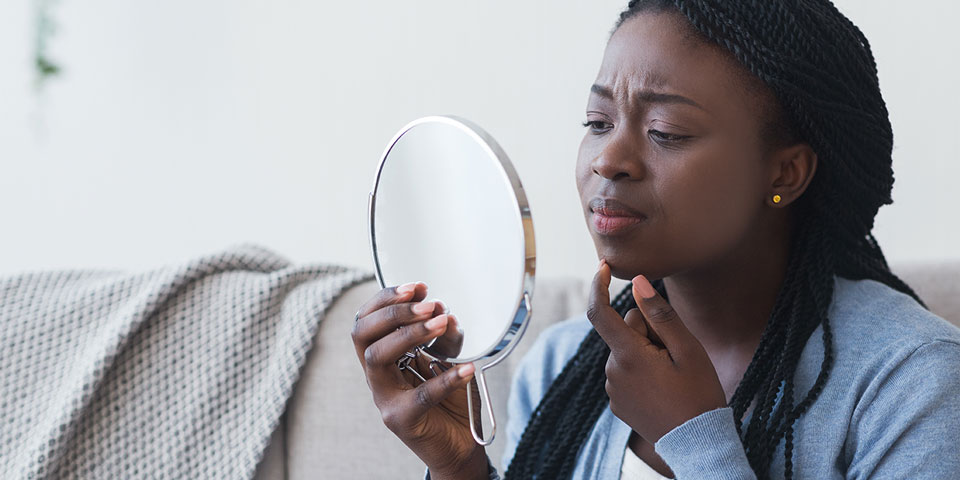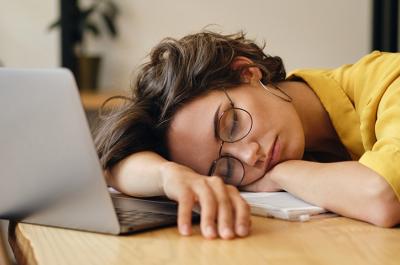Hormonal acne: 6 tips to manage and care for your skin

Oh, acne. It’s often a defining factor of our teenage years, but for some of us, it doesn’t end after adolescence. If you’ve ever gotten a breakout just before your period starts, hormonal acne could be the culprit. Let’s explore what hormonal acne is, what causes it and how you can treat it.
What is hormonal acne, and what causes it?
Broadly speaking, acne blemishes come from interactions between skin oils, dead skin cells and bacteria.1 Sebum (the oily liquid your skin creates in your sebaceous glands) mixes with dead skin cells and inadvertently plugs up your pores. From there, bacteria can cause additional inflammation.
Many factors, like stress,2 hair or skin care products that may clog pores,2 your family history2 or your diet3 can increase your likelihood of experiencing acne as an adult. So can your hormones.
Hormonal acne, as the name suggests, is acne caused by fluctuating hormone levels.2 Two prominent players in hormonal acne are hormones you might already recognize: androgens (like testosterone) and estrogen.
The way your sebaceous glands function is directly affected by the balance of androgens and estrogen in your body.4 Androgens stimulate them and increase production of oily sebum, while estrogen inhibits them and the production of androgens.4 So higher levels of androgens could mean a greater risk of oily skin and more opportunities for pimples to form, and higher levels of estrogen could mean less oil on your skin and a lower risk of pimples. The ratio between these hormones isn’t the only hormonal factor that may lead to acne, but if you’re experiencing changes in either one, that may be the source.
Women often experience hormonal acne before or during their period (which is why you may have also heard the term “period acne”). Hormonal acne may also occur during pregnancy or at the onset of menopause and perimenopause. Stopping or starting hormonal birth control is another potential trigger.2,5
In general, acne commonly shows up on your forehead, face, neck, back, chest or shoulders,5,6 the areas of the skin where the most sebum is produced.6
How do I know if my acne is hormonal?
Acne can be caused by anything from a change in your skin care routine to a difference in your environment. Here are some ways to determine if the cause of your acne is triggered by hormonal fluctuation:
Track the timing.
Do you tend to get similar breakouts at certain points in your menstrual cycle? Try tracking them with a calendar (like you’d track your period to get an idea of whether your breakouts are connected to hormone fluctuations.
Pay attention to your breakouts.
Is acne new for you? Or are you experiencing a pattern of breakouts you’ve not seen before — in a different place, or with a different kind of blemish? If so, that could indicate your acne is the result of a recent shift, potentially a change in your hormone levels.
Talk to your doctor.
During a check-up, your doctor can help see if you’re experiencing hormonal acne. They’ll look at the severity of your acne and where it is on your body7 — and may ask you about your skin care routine or possible contributing factors.
Can I prevent hormonal acne?
Not exactly. Hormonal acne happens as your hormone levels fluctuate, so you can’t exactly avoid it. However, there are steps you can take to prepare your skin and fight flare-ups. We’ll talk more about that next.
How to manage hormonal acne
Everyone is different, so what works for one person may not work for you. Here are six tips to bear in mind when dealing with hormonal acne.
1. Visit a dermatologist.
If you’re concerned, think about seeing a dermatologist. If necessary, dermatologists can give you prescription-strength medications, like retinoids or antibiotics, to help treat hormonal acne.6
2. Wash your face gently and regularly.
Your skin may be the largest organ of your body, but that doesn’t mean you should be rough with it. When washing your face, use clean hands, mild soap and warm-but-not-too-warm water. Skip the coarse washcloths and harsh scrubbing — these can irritate the skin and may even make your acne worse.8 Stick to washing your face once in the morning and once at night, or after you’ve been sweating.8
3. Resist the urge to pick at blemishes.
The temptation is real to deal with breakouts by poking and prodding your blemishes. But when you pick at acne, you interrupt your skin’s natural healing process and can prevent it from clearing up quickly. Popping or scratching at pimples can injure your skin and may even cause scarring.8
Bottom line: It’s best to keep your hands off your face as much as possible, unless you’re gently washing it as recommended.8
4. Avoid sunbathing and tanning to keep sebum production under control.
It’s no secret that the sun and tanning bed can damage your skin: Exposure to UV light can lead to premature aging of the skin and suppress your immune system.9 It can also temporarily increase the amount of sebum your skin secretes, increasing your risk for acne flare-ups.10 So try to stay away from the sun and tanning beds. If you can’t, use an oil-free moisturizer with sunscreen to protect yourself.
5. Use makeup and skincare products that won’t clog your pores.
Not all makeup and skin care products are the same, and some are better designed for handling and caring for acne. Noncomedogenic products — ones that are less likely to clog your pores — give your skin a better shot at avoiding breakouts.11 Take a close look at the labels on your skin care and makeup products and look for terms like “noncomedogenic,” “oil-free” or “non-acnegenic”2 — these descriptors indicate that the product is less likely to cause acne or make it worse.
If you’re concerned about changing your routine, talk to a dermatologist about your options.
6. Look at what’s available to you.
If you’ve experienced acne before, you might already have go-to products for handling it. But if acne is new to you, or if your former favorites aren’t doing the trick for your current hormonal acne, there are plenty of options to try in the skincare aisle and beyond! Topical treatments like tea tree oil or oral supplements like zinc, for example, can both be effective acne-care ingredients.12
It’s a good idea to talk to your doctor first about trying any new-to-you treatments. They can help you identify which options would be good candidates for you and your skin. And keep an eye out for common side effects like dryness and irritation, or more-specific ones related to the treatment you pick, or existing health concerns.
Hormonal acne is completely normal. By paying attention to your well-being and talking to a doctor, you can take better care of yourself and your skin.
Related Blog Content
Sources
- Mayo Clinic. “How acne develops.” Accessed 18 Oct. 2022. https://www.mayoclinic.org/diseases-conditions/acne/multimedia/how-acne-develops/img-20007668
- American Academy of Dermatology Association. “Adult Acne.” Accessed 23 Aug. 2022. https://www.aad.org/public/diseases/acne/really-acne/adult-acne
- Kristina Liu, MD, and Janelle Nassim, MD. “Adult acne: Understanding underlying causes and banishing breakouts.” Harvard Health Publishing. 2019. Accessed 18 Oct. 2022. https://www.health.harvard.edu/blog/adult-acne-understanding-underlying-causes-and-banishing-breakouts-2019092117816
- Edileia Bagatin, Thais Helena Proença de Freitas, Maria Cecilia Rivitti Machado, Beatriz Medeiros Ribeiro, Samanta Nunes, and Marco Alexandre Dias da Rocha. “Adult female acne: a guide to clinical practice.” National Library of Medicine. 2019. Accessed 23 Aug. 2022. https://www.ncbi.nlm.nih.gov/pmc/articles/PMC6360964/
- National Institute of Arthritis and Musculoskeletal and Skin Diseases. “Acne.” Accessed 29 Aug. 2022. https://www.niams.nih.gov/health-topics/acne#tab-causes
- Mayo Clinic. “Acne: Symptoms & causes.” Accessed 18 Oct. 2022. https://www.mayoclinic.org/diseases-conditions/acne/symptoms-causes/syc-20368047
- National Health Service. “Acne – Diagnosis.” Accessed 19 Sept. 2022. https://www.nhs.uk/conditions/acne/diagnosis/
- American Academy of Dermatology Association. “Acne: Tips for Managing.” Accessed 23 Aug. 2022. https://www.aad.org/public/diseases/acne/skin-care/tips
- Yasuhiro Matsumura, Honnavara N Ananthaswamy. “Toxic effects of ultraviolet radiation on the skin.” National Library of Medicine. 2004. Accessed 19 Sept. 2022. https://pubmed.ncbi.nlm.nih.gov/15020192/
- B. Dréno, V. Bettoli, E. Araviiskaia, M. Sanchez Viera, and A. Bouloc. “The influence of exposome on acne.” National Library of Medicine. 2018. Accessed 21 Sept. 2022. https://www.ncbi.nlm.nih.gov/pmc/articles/PMC5947266/
- National Institutes of Health. “Acne Breakouts: Controlling Problem Pimples.” News in Health. 2018. Accessed 23 Aug. 2022. https://newsinhealth.nih.gov/2018/07/acne-breakouts
- Brent A. Bauer, M.D. “Natural acne treatment: What’s most effective?” Mayo Clinic. Accessed 23 Aug. 2022. https://www.mayoclinic.org/diseases-conditions/acne/expert-answers/natural-acne-treatment/faq-20057915




